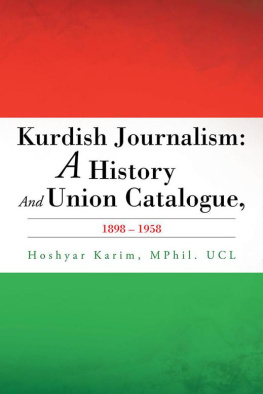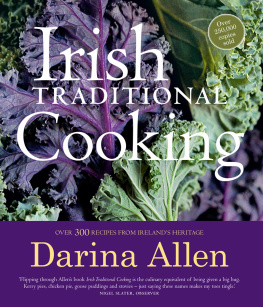
An insight into Kurdish culinary heritage
About the Author Ala Barzinji is from Southern Kurdistan and has been a British resident since 1995. She uses food to keep alive the connection with her homeland and to teach her children about their heritage. After working for various IT companies, she now runs her own IT business and is also a managing director for a medical company in Kent. She always enjoyed watching her mother when she was cooking for the family or when she was teaching others how to cook traditional Kurdish recipes. Now with a postgraduate degree in mathematics and computing, and an interest in photography and organic gardening, Ala enjoys exploring the Kentish countryside and, of course, cooking. Copyright information Copyright Ala Barzinji (2015) The right of Ala Barzinji to be identified as author of this work has been asserted by her in accordance with section 77 and 78 of the Copyright, Designs and Patents Act 1988.
All rights reserved. No part of this publication may be reproduced, stored in a retrieval system, or transmitted in any form or by any means, electronic, mechanical, photocopying, recording, or otherwise, without the prior permission of the publishers. Any person who commits any unauthorized act in relation to this publication may be liable to criminal prosecution and civil claims for damages. A CIP catalogue record for this title is available from the British Library. More information can be found at the books website, www.kurdishfood.co.uk Acknowledgments First I want to thank my beloved mother who taught me to cook and passed down so many Kurdish traditions, recipes and our culture to me.
Giya le ser binc xoyi derrwtewe  , a relevant Kurdish proverb. (The literal translation is: Grass grows on its roots.
, a relevant Kurdish proverb. (The literal translation is: Grass grows on its roots.
The comparable English saying is: The apple does not fall far from the tree.) I also thank my family, who have eaten exceptionally well while I prepared this book! I have been always on the lookout for books about other nations traditions, including traditional cook books. The absence of a book on Kurdish food on the shelves made me think of preparing a book on traditional Kurdish food. The idea was in my mind for several years before I decided to start working on it. I hope you will enjoy the window into Kurdish life and food that my book provides. Eat well and keep well. Ala Barzinji Author and proud Kurd Welcome to Kurdish cooking Its always a privilege to participate in a traditional family meal.
The recipes of this book are traditional, widely-practised and strongly honoured throughout Kurdish families, wherever they live. They remind us of home and childhood, from mums cosy kitchen and family dinners to festive family gatherings. The recipes in this book have been handed down from mother to daughter as is customary in many cultures. Traditional Kurdish Food includes authentic recipes from the South of Kurdistan (Iraqi Kurdistan). There are dishes to suit every occasion, whether you are preparing a quick and simple meal or a more elaborate dish. It also provides links to traditional Kurdish culture, such as buying produce in the local market and the focus on fresh vegetables and herbs.
Kurdish food is broadly simple in nature, but rich in nutrition. All the recipes are nutritionally balanced and can be tailored to suit people with special diets. A good proportion of the recipes are suitable for vegetarians and many others can be prepared without the meat while preserving their taste and character.
Cultural and geographic aspects Kurdish cooking benefits from geographical diversity. For example, the dishes of slemani (sulaymaniyah), Kirmanshah, Qamishli and Diyarbakir all have their own character. The two common factors of Kurdish cooking are the freshness of the ingredients and the creative use of seasonal ingredients and spices.
Good food has always been essential to Kurdish way of life. Kurds are extremely proud of their culinary culture with its rich, varied and venerable cuisine. Good food has always been essential to Kurdish people. Its not the dish that matters but the taste. The offering and sharing of food are an expression of friendship and generous hospitality, and it is considered impolite to refuse food you have been offered. Kurdistan has a climate and soil suited to olive trees tirshasmaq (sumac), grapes, pomegranates, figs and walnuts.
Kurdish honey has a distinctive taste and is often sold with the honeycomb. Kurdistan also produces dairy products like sheep and cow milk, yoghurt, cheese and qaymagh (clotted cream).
Vegetables and herbs Vegetables and herbs play central roles in almost every aspect of the Kurdish menu. Many herbs grow freely in Kurdistans climate, especially mint, basil, parsley, celery, spinach, chard (silq), thyme, chives and many more. They are all used extensively in Kurdish cooking. Kurdish people dry their vegetables and herbs under direct sunlight to store them.
Okra, aubergine, celery leaves, mint and many more foods can be dried under direct sunlight to preserve them for future use.
Festival food The festival of Nawroz, or Kurdish New Year, is celebrated among Kurds. In Kurdish history, the holiday celebrates the deliverance of the Kurds from a tyrant and is the symbol of freedom and preservation of Kurdish identity. The New Year falls on 21 March. On the Kurdish New Years Eve, the celebration starts when people light a fire and dance around it. The date coincides with the northern spring equinox which usually falls on or near the 21st.
Kurds gather together in fairgrounds in the cities to welcome spring. Men and women wear traditional attire and celebrate by dancing. Traditionally, gallamw yaprakh is the main dish.
About Kurds Kurdistan Region is an autonomous region of northern Iraq; its people are called Kurds. Since at least 4000 BC, Kurds have represented about 15% of the overall population of the Middle East. Since the late 19th century, Kurds have suffered an enormously negative demographic trend due to wars, deportations, famines and those combined impacts on a developing economy.
The Kurdish homeland is approximately 390,000 km. Kurdistan is mainly a mountainous area, but with large tracts of arable land between forests. Rain and the presence of many rivers help to make these lands fertile in fact Kurdistan is the source of the Tigris and Euphrates rivers, which are believed to have created the Cradle of Civilisation in ancient Mesopotamia. The very invention of agriculture and domestication of animals took place primarily in Kurdistan around 12,000 years ago. Kurdistan remains unique to this day, and our heritage and history remain reflected in our food.
Jarmo: a perfect example of Kurdish history and food Qalat Jarmo (or simply Jarmo) is an archaeological site dating back to 7090 BC.
It is located in northeast Iraqi Kurdistan, on the foothills of the Zagros Mountains, east of Kirkuk. There are oak and pistachio woodlands stretching out for three acres, 800 metres above sea level. Jarmos development is confirmed by discoveries of stone sickles, bowls, cutters and other objects for harvesting and storing food. Perforating tools and spoons have also been found. The villagers of Jarmo grew two types of wheat, emmer and einkorn, which are types of primitive barley and lentils. There is also evidence of the domestication of goats, sheep, dogs and pigs.















 , a relevant Kurdish proverb. (The literal translation is: Grass grows on its roots.
, a relevant Kurdish proverb. (The literal translation is: Grass grows on its roots.